Taima Shukaku (Hemp Harvest)
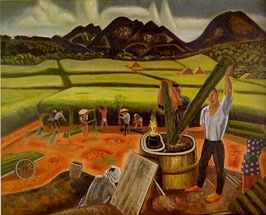
In 1929, one of the most celebrated paintings of its time, Shimizu's
Taima Shukaku (Hemp Harvest) depicts farmers cutting down thick,
dense hemp fields, surrounded by a vibrant valley.
This painting was a finalist for a kind of national "painting of the
year" award from the Japanese government.
Military garments
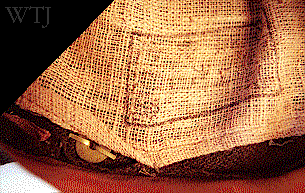
This is a military cap as used by Japanese soldiers in WW2. It was
made from hemp grown in the mountain valleys of Japan.
Japanese government permit to cultivate cannabis hemp

Until 1948 hemp could be grown by anybody, anywhere in Japan, without any
legal restrictions. Then the Hemp Control Law passed under American occupation
required anybody wanting to cultivate the plant to obtain a government license.
Initially that law was largely ignored. By the time the law was enforced
very few hemp farmers were left in the country. In 1997 Mr. Marui, a lawyer
specialising in marijuana cases, obtained two grow permits, one for
Mr. Nakayama, a young farmer in Shizuoka, and another for himself for research
purposes.
Hemp rope and hemp paper streamers in Shinto shrines

Hemp rope and hemp paper
in 400 year old shrine in Saitama
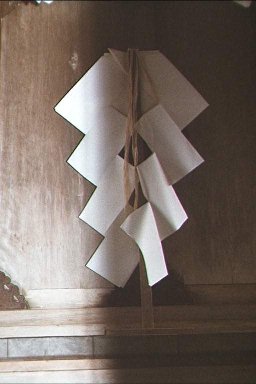
Unprocessed hemp fibre, hemp paper streamers
(Shinto shrine in Sami village, Gifu)
Ancient Cave Painting from Kyushu, Japan.
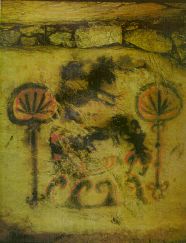
(Dave Olson collection)
How the Yen got it's name
 The Japanese currency, the yen (¥) is pronounced en
in Japanese and its kanji (Chinese character) also means circle,
or round. It received that name because the coins literally used to be
circles with a hole in the middle, just like a washer. In fact two of the yen
coins in circulation today, the 5 yen and 50 yen coins are still like that.
The reason for the hole is that coins used to be lined up on hemp strings
and carried around like that. In historic Japan (as in China and Korea
before) everybody's wallet used to be a piece of hemp, the most durable
and trusted natural fibre known to man.
The Japanese currency, the yen (¥) is pronounced en
in Japanese and its kanji (Chinese character) also means circle,
or round. It received that name because the coins literally used to be
circles with a hole in the middle, just like a washer. In fact two of the yen
coins in circulation today, the 5 yen and 50 yen coins are still like that.
The reason for the hole is that coins used to be lined up on hemp strings
and carried around like that. In historic Japan (as in China and Korea
before) everybody's wallet used to be a piece of hemp, the most durable
and trusted natural fibre known to man.
These are some of the oldest coins ever found in Japan. They have
never been in circulation after having been minted. Every one of
them has a square hole in the middle, to go onto a hemp string like
beads on a necklace.
Fine Japanese Hemp from Aurora Dyeworks.
Cheryl Kolander Collection
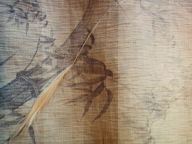
|
Fine Japanese Hemp from Aurora Dyeworks.
Cheryl Kolander Collection

|
Fine Japanese Hemp from Aurora Dyeworks.
Cheryl Kolander Collection

|
Fine Japanese Hemp from Aurora Dyeworks.
Cheryl Kolander Collection
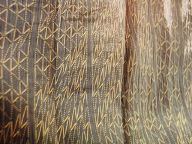
|
Hemp Noren (Curtain)
(Dave Olson collection)

|
Noren Detail (note background pattern)
(Dave Olson collection)

|

'Asa no ha' pattern
|
The Asanoha (Hemp Leaf) pattern is a popular traditional pattern often seen
on Japanese kimono. Though often people forget about this today, the regular
geometric pattern represents overlapping hemp leaves.
Because hemp was known for it's rapid growth, the pattern was
often used for clothes of newborn children. The wives of merchants would
also often wear it. It was believed to bring good fortune to the wearer.
See also:

 Traditional patterns in Japan
Traditional patterns in Japan
|

|



